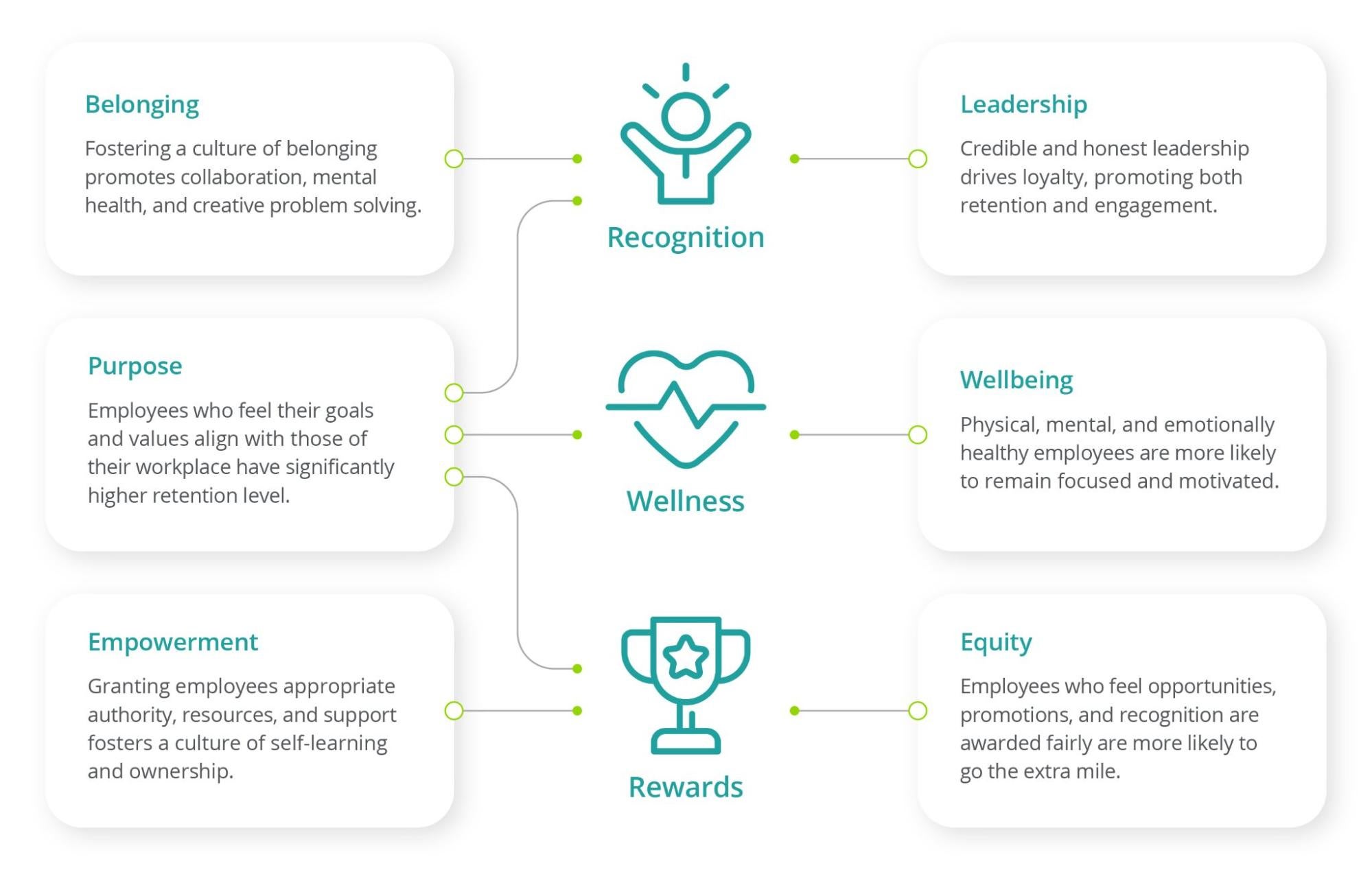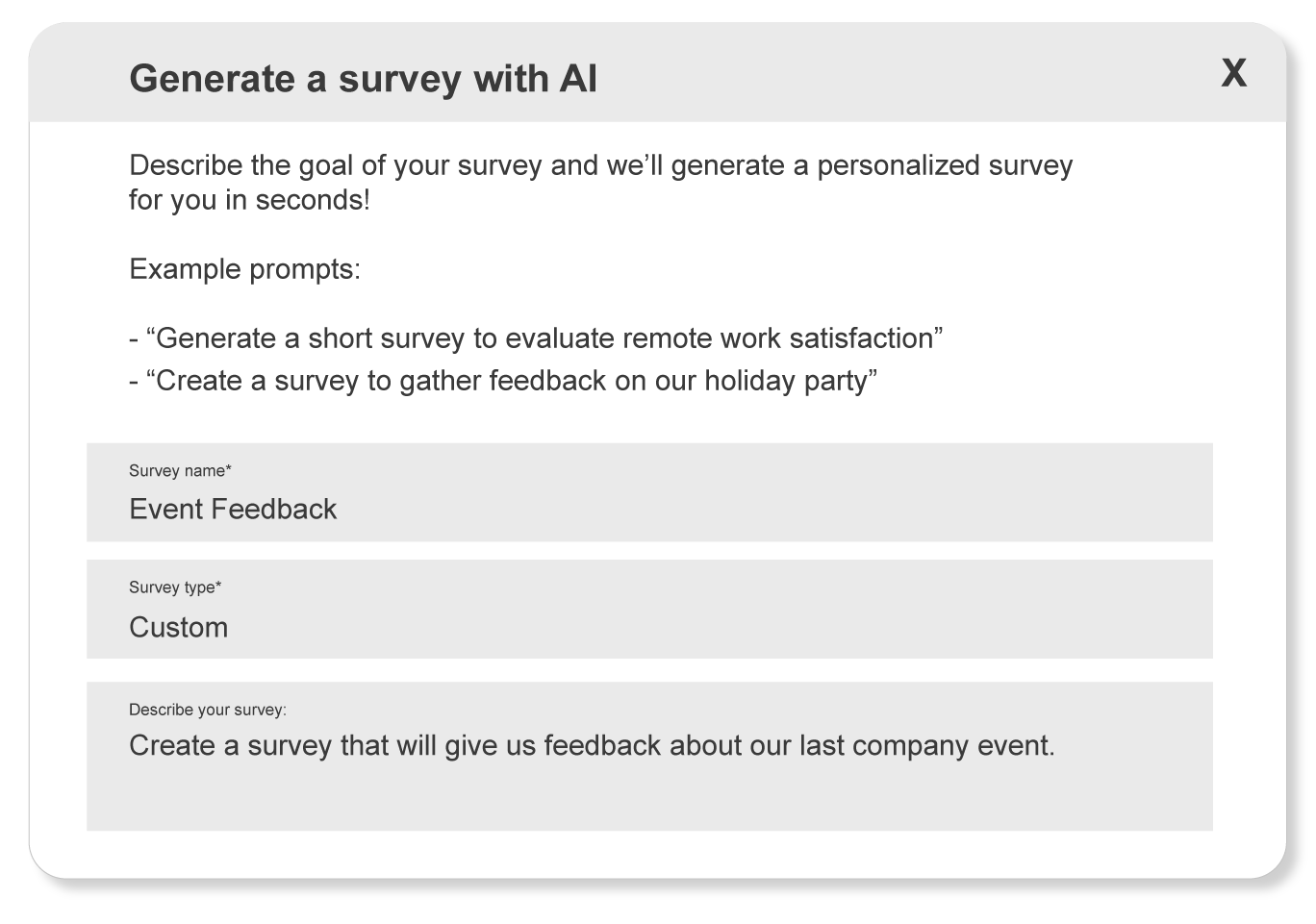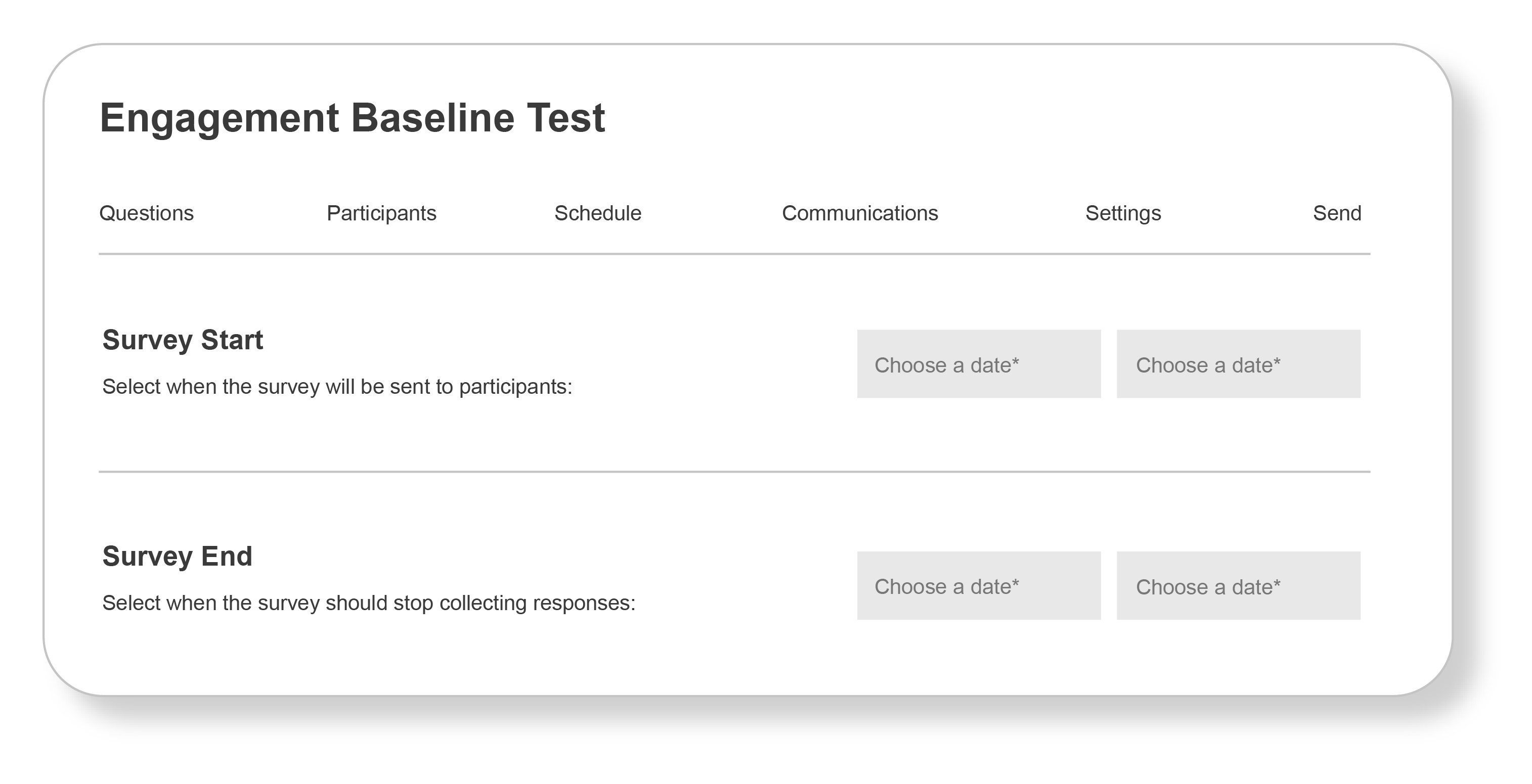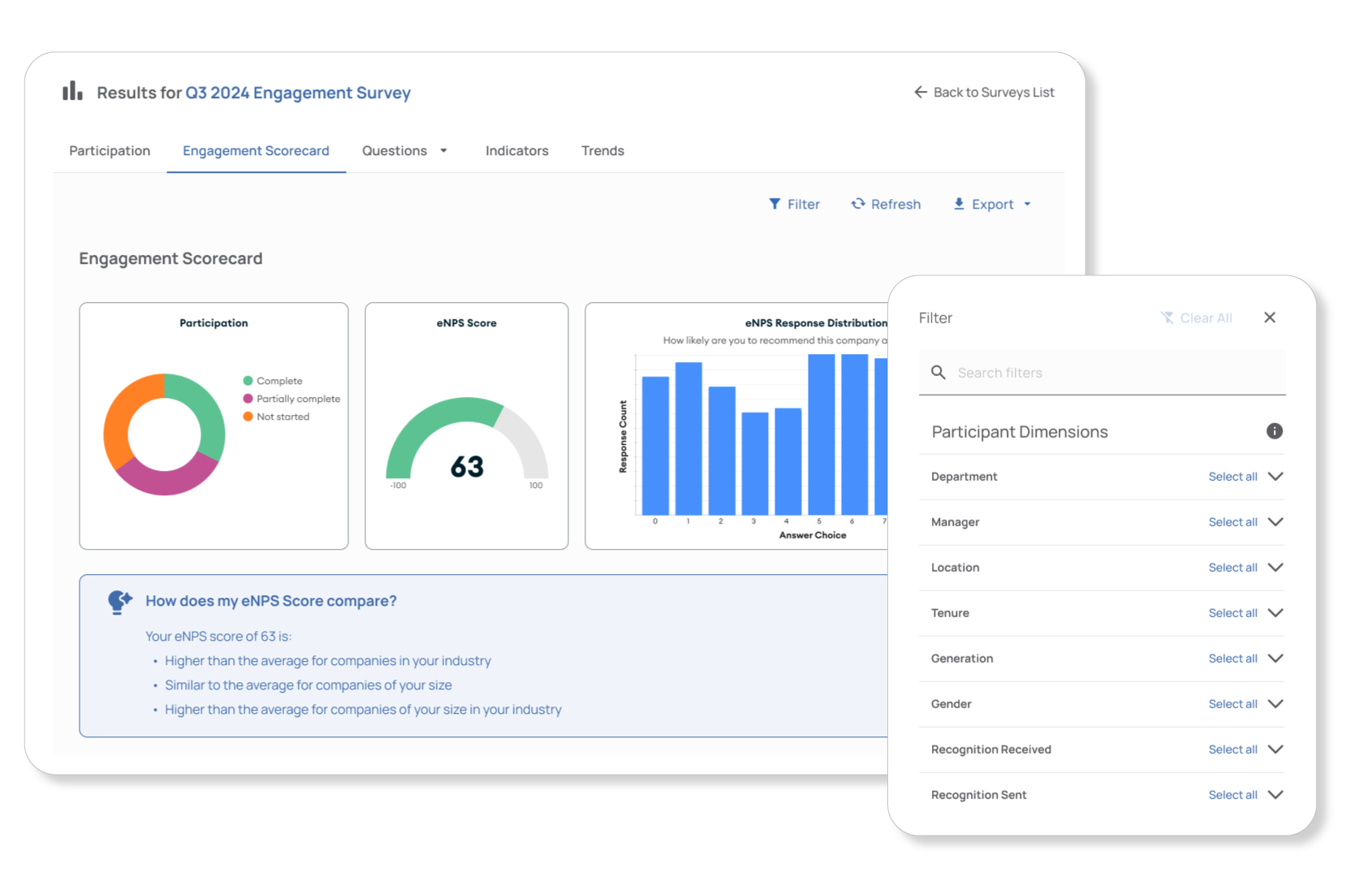April 28, 2025

A basic, templated employee satisfaction survey can provide insight into how satisfied employees are with specific aspects of their work. For example, are they happy with their compensation package? Do they feel supported in their role? Are they satisfied with their manager’s communication?
While these surveys offer useful insights into how employees feel about their jobs, they don’t explain why they feel this way or how these sentiments impact their work. To gain a deeper understanding, research bodies have developed more nuanced survey questions and methodologies that measure factors like employees’ sense of belonging or equity.
In this guide, we cover:
- An employee satisfaction survey template that you can use to immediately start surveying your team and understand their satisfaction with their role and workplace environment.
- How to uncover deeper employee engagement insights that impact performance and retention.
- Practical advice for choosing the right surveys, running them at the right time, and extracting actionable insights from the data you collect.
- How employee listening tools can help you automatically design and run surveys, uncover actionable insights, and how combining employee recognition and wellness with employee listening drives engagement.
Get Started with a Standard Employee Satisfaction Survey Template
This standard employee satisfaction survey template offers a simple way to gauge how employees feel about the support they receive, the resources available to them, and their overall work environment.
It includes statements rated on a scale from “strongly disagree” to “strongly agree,” though you can customize the response options as needed.
Note: As we explain later, this standalone survey won’t give you the deeper insights needed to meaningfully improve employee engagement and retention.
Here’s the example survey to get you started:
- I am satisfied with my current role and responsibilities.
- I feel supported by my immediate supervisor.
- I have a good working relationship with my co-workers.
- I enjoy my current working environment.
- I am satisfied with the fairness of compensation and benefits.
- I am satisfied with the resources and tools provided to perform my job effectively.
- I can make mistakes without fear that my coworkers will hold it against me.
- It is safe to ask other members of this team for help.
- I can see our core values being practiced in the business.
You can also swap in or add any of these statements:
- I feel comfortable sharing my opinions and ideas with colleagues.
- I have the resources I need from [company name].
- I am excited about my future at [company name].
- On my team, my unique skills are valued.
- I feel my efforts and contributions are adequately acknowledged.
- I am satisfied with the opportunities for career advancement within the organization.
- What motivates you to perform at your best? [This is an open-ended question for collecting qualitative data.]
Beyond Surface-Level Insights: A Scientific Approach to Employee Listening & Engagement
A basic employee satisfaction survey gives you a general sense of how people feel and their likelihood to churn. But it won’t give you the full picture of employee engagement or uncover what’s driving motivation, performance, and retention. If a specific team is at risk, what’s the contributing factor?
Our research shows that key indicators like leadership, belonging, and well-being are closely tied to employee engagement. They reveal how employees feel and how those feelings impact their work.
If your goal is to improve employee retention, you need to measure these factors alongside eNPS to pinpoint which groups are most at risk—and why.
Maybe you’ll discover that top performers are most likely to churn (low eNPS) because they feel burned out (low well-being scores), or they don’t stick around because they don’t believe they’ll be promoted (low equity scores).
Pinpointing these root causes starts with asking the right questions—those scientifically proven to reveal underlying strengths and challenges.
With the help of three independent Ph.D. researchers, we’ve developed a culture model designed to uncover specific employee engagement insights, using surveys backed by I/O psychologists.

Our culture model predicts employee engagement by measuring six key “engagement indicators”: belonging, leadership, equity, purpose, empowerment, and well-being.
Each indicator is directly tied to specific outcomes.
For example, a strong sense of purpose and confidence in leadership drive retention, while well-being and equity keep people motivated and boost performance:

Our engagement baseline survey includes 38 questions measuring engagement across these six key indicators.
For example, the question “I feel a sense of belonging at my work” corresponds to a sense of belonging, while “My direct supervisor gives encouragement and recognition to staff” is one of seven questions that measure leadership.
The purpose of these questions is to assess the factors impacting your team’s engagement, both positively and negatively. You’ll understand how they feel about their leaders, if they align with your company’s vision, how included they feel, and more.
Running the baseline survey will give you a set of scores corresponding to each indicator, which can be either positive or negative. For instance, you might score +20 on empowerment but -3 on well-being, indicating a need to support employees’ physical or mental health.
This data helps you identify exactly which factors to address in order to improve employee engagement within your organization (or specific teams).
How to Capture & Measure Engagement through Employee Satisfaction Surveys: 3 Key Considerations
To get the most out of your employee satisfaction surveys, it’s important to ask the right questions at the right time, understand the broader context behind the data you collect, and take meaningful action.
1. Choosing the Right Survey Type & Cadence
The companies we work with that have a strong pulse on employee satisfaction and engagement typically use a combination of surveys and conduct them frequently.
For example, they don’t rely solely on the initial baseline survey. Instead, they analyze insights from it, break down the data by different cohorts, and run drill-down surveys to better understand the sentiments of specific segments. If, for instance, the baseline survey reveals that the sales department scored lowest in “leadership,” they might launch a 360-degree survey to assess leadership within that department.
We’re strong advocates for pulse surveys because their frequency allows you to track how employees feel about their workplace, new initiatives, leadership, etc., and take action before any problems compound.
2. Interpreting Your Findings
Depending on the type of surveys you run, the results might include eNPS or Likert scores. If you’re using science-backed surveys, you may also track additional insights, such as the six engagement indicators our surveys measure.
Regardless of the specific metrics, contextualizing the data helps you understand the broader picture—why employees feel the way they do and what’s driving changes in their sentiments. That’s why we advocate for combining insights from employee listening with other employee engagement programs, like recognition and wellness.
For example, it’s common for companies to find that their most recognized employees score lower in job satisfaction over time. This often happens when employees are initially passionate about their original role, leading them to start off very satisfied.
However, as time passes, they’re given more responsibilities and their role evolves, earning them more recognition. But their lack of passion for these additional tasks can lead to a decrease in job satisfaction.
3. Taking Action
The insights you collect can help you refine your employee engagement programs and develop strategies to achieve specific goals, like improving retention.
We strongly advocate for small-scale, tailored engagement programs that address the needs of specific segments. Our customers use these targeted programs to boost engagement and align teams with shared company goals.
While organization-wide programs, such as employee recognition, are great for overall engagement, the data you collect can reveal specific challenges. For instance, if one department feels unsupported or another experiences high burnout rates, tailored programs for those segments can address these issues more effectively.
Employee Listening Software: Run Employee Engagement Surveys & Uncover Actionable Insights on Autopilot
By automating the administrative tasks involved in running engagement surveys, you can focus on gathering insights and taking action. That’s where employee listening software like Terryberry comes in.
Terryberry streamlines the process of creating, running, and interpreting employee engagement surveys. With Terryberry, you can:
1. Launch Ready-Made Surveys from the Survey Library
Looking to get a general overview of employee satisfaction and engagement? Start with our baseline survey, designed by PhD researchers and backed by I/O psychologists.
The library also offers targeted surveys to gather specific insights on employee satisfaction. For example, new hire and stay surveys capture employee sentiment at the start of their jobs and after they’ve settled in. Exit surveys can help you understand what departing employees appreciated about their roles and potentially uncover reasons for turnover.
Need surveys tailored to specific goals? Terryberry’s AI survey helper can quickly design a custom survey for you. Just specify your objectives, and the AI will create a survey using relevant questions from Terryberry’s library, making adjustments as needed.

Your goals might include measuring employee sentiment around a new initiative, leader, or work mode (remote, hybrid, or in-office).
Once you’ve selected or designed your survey, it’s all about maximizing participation. That’s where Terryberry steps in. We build out the communications for your survey, including initial messages, reminders, and follow-ups, and distribute them across channels.
With Terryberry’s employee listening tool, you can schedule surveys, along with follow-ups and drill downs, in advance:

Based on our internal research, we’ll recommend the best dates to send reminders and follow-ups to maximize participation.
Surveys are delivered through the channels your teams use most—Slack, Teams, or email—and can also be exported for easy access by non-desk workers.
2. Follow Up with the Right People at the Right Time
Terryberry’s employee listening platform tracks which surveys you’ve run and who participated, so it’s easy to send follow-up and drill-down surveys when needed.
After your initial survey(s), the analytics and indicator dashboards uncover opportunities for improvement. You’ll see eNPS and Likert scores, participant breakdowns, and scores across our six engagement indicators—plus recommendations on where to focus next.
For example, let’s say you run Terryberry’s engagement baseline survey; your dashboard will show scores for each of the six indicators.
Maybe you score 10 in belonging but -2 in leadership.
In this case, you might launch an initiative to improve people’s sentiments towards leadership and then use a leadership drill-down survey to measure the impact of your efforts.
Follow-up surveys don’t necessarily need to target your entire initial pool of participants, either. Many companies we work with uncover trends in specific segments after their initial engagement baseline survey, which they can see using the filters in the analytics dashboard:

So, you can identify trends across specific cohorts using these filters, such as gender, ethnicity, department, and work arrangements (part-time or full-time).
For example, if women in the finance department score low in “equity,” you can implement changes and follow up with an equity survey later on to measure its impact.
3. Combining Employee Listening with Recognition & Wellness
An employee listening program can help measure employee satisfaction and engagement and track changes in sentiment over time. However, without complementary engagement programs, like recognition or wellness, you can’t actively improve engagement.
That’s why we built Terryberry: to help organizations launch and scale employee listening, recognition, and wellness programs all in one centralized platform. This means that once you measure employee satisfaction and uncover areas needing attention, you can launch tailored programs to address those issues.
Importantly, having insights from recognition, wellness, and employee listening in a single platform means you can track how these programs impact each other.
For example, you can measure how recognition affects detractors and overall eNPS or assess how engaged your most recognized employees are in your wellness program. These insights help you build a strong business case for your engagement programs by proving their impact on broader business goals, such as improving retention or boosting team productivity.
Many businesses we work with realize they need engagement programs like recognition after surveys reveal underlying gaps—e.g., employees may not be connecting with company goals or could be showing signs of burnout.

In Amteck’s case, a family-owned construction company, the company realized its employees were losing connection with the company’s core values. Matt Noble, Marketing and Communications Manager at Amteck, explained how they picked up on this problem through employee listening:
"When we asked people about Amteck's core values, only 1 in 10 employees could articulate them correctly. This was a wake-up call, highlighting the need to show appreciation in ways that resonated and aligned with our core values."
This realization prompted Amteck to launch an employee recognition program with Terryberry’s help to reinforce the company’s core values through custom awards.
Terryberry’s solution lets you build tailored engagement programs tied to values and goals. You could tie manager or peer recognition to company core values, or your wellness program to specific physical or mental health goals.
For example, Chelsea Groton Bank, the largest mutual bank in Eastern Connecticut, wanted to develop an employee recognition program that tied recognition to the company’s core values through a gamified experience.
Their program, called Acorn Rewards, involves:
- Linking peer recognition to core values. When team members observe a peer demonstrating one of Chelsea Groton’s core values, they can award them a “Purple Acorn Award” on Terryberry’s recognition platform. We configured Terryberry’s “Give a WOW” feature—which lets peers recognize each other and nominate colleagues for awards—to the company’s seven core values: being innovative, collaborative, trustworthy, professional, knowledgeable, versatile, and positive.
- Different recognition levels. After collecting 10 Purple Acorns, an employee receives a custom plush toy—a “Happy Squirrel”. For every additional 10 Purple Acorns they collect, the team member is awarded points that they can exchange for luxury and lifestyle goods.
Programs like Acorn Rewards help companies drive employee engagement and meet specific objectives.
Launch Science-Backed Surveys & Tailored Employee Engagement Programs with Terryberry
Go beyond basic employee satisfaction surveys and capture deep insights into employee engagement with Terryberry’s culture model. Choose from our library of pre-made surveys or create custom ones with our AI. Use Terryberry to track analytics and participation data, schedule your surveys in advance, and run follow-up or drill-down surveys.
Terryberry’s analytics and indicator dashboards display eNPS, Likert, and engagement indicator scores, alongside industry benchmarks. Our indicator dashboard also highlights your top opportunities for improving employee engagement.
Terryberry’s employee listening tool integrates with our configurable employee recognition and wellness modules, allowing you to take action based on survey insights—all within a single, centralized platform.
Schedule a demo today to uncover valuable insights into employee engagement and take action with Terryberry’s science-backed surveys and fully integrated employee engagement platform.
